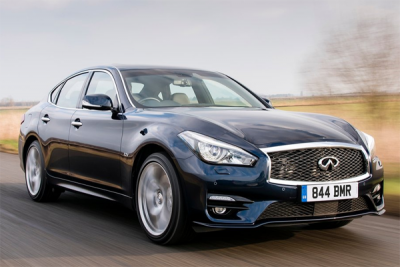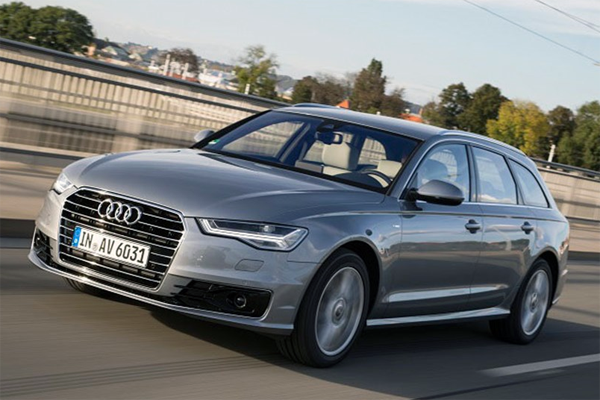 The premium large car segment in Europe has found the way back up again, with sales improving 4,4% in Q3, bringing the year-to-date score to -2%, from -5% in the first half of the year. The ongoing three-way battle between the Audi A6, BMW 5-series and Mercedes-Benz E-Class appears to be decided for 2015, with the A6 extending its lead in Q3, even if the 5-series gained 9,1% this quarter and sold just 300 units less than its rival. This also put the 5-er well ahead of the E-Class to consolidate its #2 spot that had been under fire in Q2.
The premium large car segment in Europe has found the way back up again, with sales improving 4,4% in Q3, bringing the year-to-date score to -2%, from -5% in the first half of the year. The ongoing three-way battle between the Audi A6, BMW 5-series and Mercedes-Benz E-Class appears to be decided for 2015, with the A6 extending its lead in Q3, even if the 5-series gained 9,1% this quarter and sold just 300 units less than its rival. This also put the 5-er well ahead of the E-Class to consolidate its #2 spot that had been under fire in Q2.
For the A6, which hadn’t led the segment since 2007, it’s likely to be a short stint on top, as both of its main competitors are being completely renewed next year. Mercedes will go first, around the end of the second quarter, and BMW will follow shortly with the new 5-series. Audi won’t renew the A6 until a year later.
In fourth place, the Volvo V70 remains one of the most stable models in the segment, with sales up 5% despite being one of the older models with its 8 years, and 2 facelifts. The jaguar XF is just as old, but the second generation is already in showrooms as you read this, so its 15% loss of volume in the first three quarters isn’t very surprising. The Tesla Model S seems to have found its sales rhythm at just over 1.000 units a month, which is pretty impressive for an all-electric car in this price range.
 As the German Big-3 are preparing to renew their core large sedans in the coming years, their trendy and stylish alternatives enjoy increased interest from European shoppers. The Mercedes-Benz CLS is up 92% in Q3 and 37% for the year so far, while the Audi A7 is up 37,5% for the quarter and 32% year-to-date. As the 5-series still scored well in the past three months, the BMW 6-series is a bit less extravagant, with sales up 9,2% in Q3, but still down 7% in the first nine months.
As the German Big-3 are preparing to renew their core large sedans in the coming years, their trendy and stylish alternatives enjoy increased interest from European shoppers. The Mercedes-Benz CLS is up 92% in Q3 and 37% for the year so far, while the Audi A7 is up 37,5% for the quarter and 32% year-to-date. As the 5-series still scored well in the past three months, the BMW 6-series is a bit less extravagant, with sales up 9,2% in Q3, but still down 7% in the first nine months.
 The Maserati Ghibli plateaus at around 1.100 units this quarter, while the Infiniti Q70 shows an impressive relative growth, but still won’t scar any of the incumbents. Even the consistently unsuccessful Lexus GS remains untouchable for its Japanese rival. Let alone for the Hyundai Genesis, which will have a tough sell in the German-dominated continent, even when the Genesis brand will be spun off from its parent to become a stand-alone, full-fledged luxury brand.
The Maserati Ghibli plateaus at around 1.100 units this quarter, while the Infiniti Q70 shows an impressive relative growth, but still won’t scar any of the incumbents. Even the consistently unsuccessful Lexus GS remains untouchable for its Japanese rival. Let alone for the Hyundai Genesis, which will have a tough sell in the German-dominated continent, even when the Genesis brand will be spun off from its parent to become a stand-alone, full-fledged luxury brand.
2015 January – September premium large car sales Europe
| Premium large car segment | Jan-Sep 2015 | Jan-Sep 2014 | Change | |
| 1. | Audi A6 / S6 / RS6 / Allroad | 71.991 | 64.649 | 11% |
| 2. | BMW 5-series | 68.313 | 75.398 | -9% |
| 3. | Mercedes-Benz E-Class | 65.679 | 78.477 | -16% |
| 4. | Volvo V70 / XC70 | 34.506 | 32.981 | 5% |
| 5. | Jaguar XF | 13.717 | 16.049 | -15% |
| 6. | Tesla Model S | 10.158 | 6.785 | 50% |
| 7. | Mercedes-Benz CLS | 10.038 | 7.330 | 37% |
| 8. | Audi A7 / S7 / RS7 | 8.146 | 6.193 | 32% |
| 9. | BMW 6-series | 5.784 | 6.245 | -7% |
| 10. | Maserati Ghibli | 3.707 | 3.359 | 10% |
| 11. | Volvo S80 | 1.774 | 2.267 | -22% |
| 12. | Lexus GS | 1.148 | 1.729 | -34% |
| 13. | Infiniti Q70 | 407 | 91 | 347% |
| 14. | Hyundai Genesis | 191 | 119 | 61% |
| 15. | Lancia Thema / Chrysler 300C | 29 | 388 | -93% |
| Segment total | 295.588 | 302.060 | -2% |
Also check out the 2015-H1 premium large car segment in the United States.
Click on any model to see its annual sales from 1997-2014 and monthly sales in 2012, 2013, 2014 and 2015, or use the dropdown menu in the top right of this site. Sources: Manufacturers, ANDC, JATO Dynamics.



